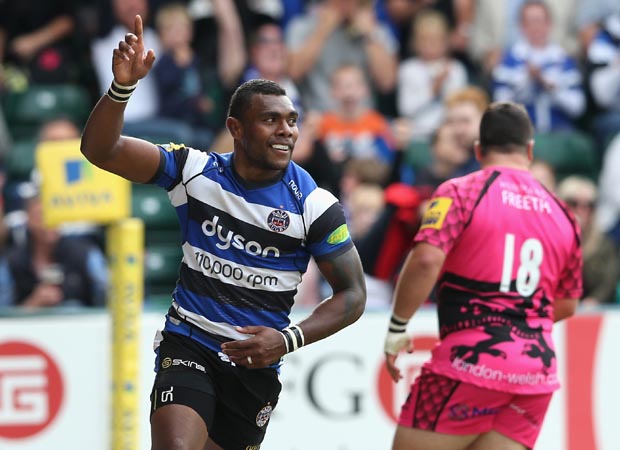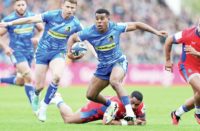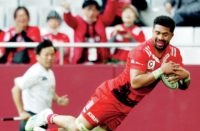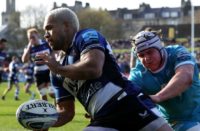 Want to know how and why Semesa Rokoduguni has forced his way into the contest for one of the England wing shirts this autumn? Look at the stats – because that's what international coaches like Stuart Lancaster do.
Want to know how and why Semesa Rokoduguni has forced his way into the contest for one of the England wing shirts this autumn? Look at the stats – because that's what international coaches like Stuart Lancaster do.
After a player has caught their eye in the Premiership or European Cup they look at whether the facts back up the impression they have made on the field. The first stat that they check out for a wing is not how many tries they've scored, but what their tackle success rate is.
Rokoduguni's success rate this season is 88 per cent, and that is a huge plus mark for Test selectors. Of the 38 tackles the Bath wing made in the opening six games of the Premiership he completed 34 successfully – and it explains why he's in England's 33-man squad for the autumn series.
Rokoduguni is also up among the highest try-scorers in the league with four, and among the top performers when it comes to defenders beaten and metres carried. So, he is way up the scale as a serious attacking threat.
His weak point is turnovers conceded. However, this is a stat that you have to watch carefully because as a wing in attack if you make a break you are very often isolated because the support is not up there with you. That's not the fault of the wing because it's his job to break clear – but, ironically, when he makes a bust it can make him vulnerable.
That probably explains why Rokoduguni has conceded ten turnovers, two more than Harlequins Marland Yarde, another wing in favour with the England selectors. For the record, Yarde's tackle success rate is also at the top end on 88 per cent.
This is why the pre-requisite of playing on the wing for your country is your defensive record. As much as we as fans like to see flair, swerve, speed, and the ability to dummy-and-go, it's still defence that's first on the list where coaches are concerned.
This always surprises me, because it's such a straightforward part of the game – and yet it takes such a crucial place in selection at international level.
I've always believed that by the time you get to into Test contention defence should be second nature. Whether it's the straight-up blitz or the soft blitz, the out-and-in, the soft drift, or sticking to your channel, you should know what you're doing and be able to adapt to what is required. What all of these defensive systems demand is that you must all be in sync, because, if someone gets out of sync it creates a dog-leg that can be exploited.
One slight break in the defensive line and it can you lose you the game – and the wingers are usually the ones who are most exposed. It explains why their concentration has to be so switched on for the full 80.
Sometimes in attack chances are spoiled because the wing has come too far up and is ahead of the ball, and the same happens in defence. There is always the temptation for a wing to shoot forward in an attempt to cut off man-and-ball when there is an overlap. However, if the attacker gets the ball away to an unmarked player it's the same as a missed tackle.
Chris Ashton is the latest high-profile try-scorer to have been given the label of not being a great defensive wing – and you have to do something pretty remarkable to shed it. Ashton is trying to do so, and in the Premiership this season he has an 83 per cent tackle success rate, which is a significant improvement on his stats last season.
It's all about risk and reward with wing selection. If you have a brilliant attacking wing who scores twice as many tries as he lets in through defensive mistakes then you almost certainly pick him.
At the moment Rokoduguni has so many plusses in defence and attack that it would have to go horribly wrong – as in messing up the whole of the England defensive strategy – for him not to be picked. The same applies to Yarde, mainly because in New Zealand he showed he is tough and can sniff out chances against the best, as he did when he ran over Richie McCaw in Dunedin.
The selections of Jack Nowell and Jonny May, England's Six Nations wings last season, for the other two places are interesting. Nowell proved that he was defensively sound during that tournament despite his inexperience, but you'd think that one and a half Premiership games is not enough rugby to be picked for the autumn series. He has attempted 27 tackles, missed six with only one turnover conceded.
May is not so far off in the defensive stats either. His tackle success rate is 84 per cent (although his involvement was not high with only 13 tackles), but he brings the bonus of being able to cover three positions as he can play outside-centre and full-back as well as wing. That, as well as his unpredictability in attack, makes him useful in freeing up other places on the bench.
However, I believe that Rokoduguni deserves a go, and I hope he gets used to playing international rugby this autumn and beds in. Yarde and Rokoduguni have a good balance as a pair. They are tough, compact physically, solid, edgy, and they can both shift.
They each have the physical power to bounce defenders off, and they won't think twice about going through a small gap and taking two or three tacklers with them. Another string to their bow is that they are good at taking strong running lines off the 9 and 10 close to the breakdown.
One bit of advice against the Southern Hemisphere sides: neither Rokoduguni or Yarde can afford to sell themselves short by getting yellow-carded for nothing when they are chasing kicks. It's about making good decisions. Going for the high ball is about timing your run and watching the ball as you reach for it with your arms. If it's not on, don't be afraid of waiting for your opponent to come down and then smashing him. Make the decision, and back yourself.
I cannot think of a better combination than Yarde and Rokoduguni, and you back them to get to places where the opposition don't want them to be, and keep their legs pumping. England don't have a Julian Savea, Bryan Habana or Israel Folau, but they have two very good wings – and they have what it takes to become dangerous Test finishers. Yarde has done it, and now it's Rokoduguni's chance.
*This article was first published in The Rugby Paper on October 26




























Pingback: Best universities in Africa
Pingback: ai nude